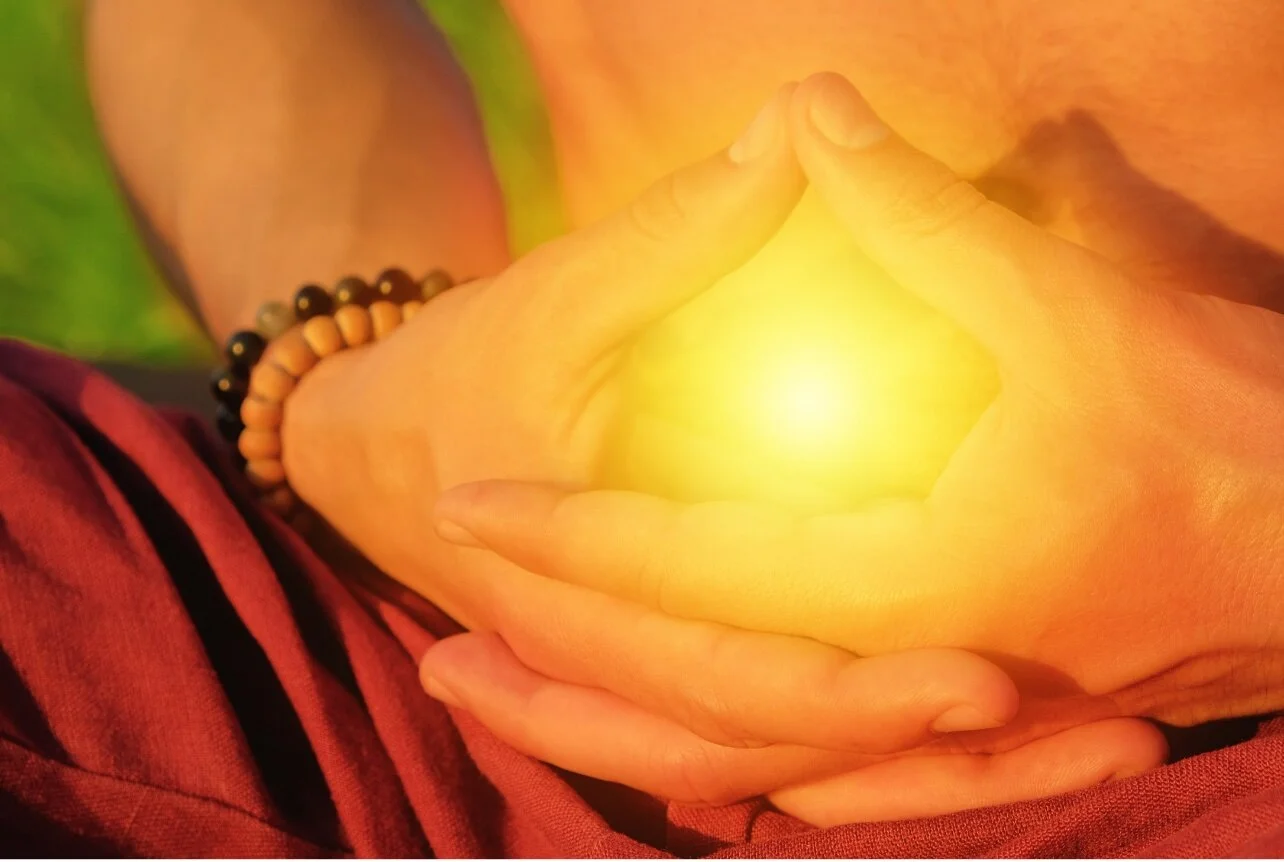The Pancha Kośas: Five Sheaths of the Human Organism
/Our bodies and minds are verbs, not nouns.
In Western thinking, we recognize that each human being has a body, a mind, and a spirit. In yoga philosophy, the belief is that each human being consists of five (Sanskrit: pancha), rather than three, layers (Sanskrit: koshas). You can visualize the five koshas of the human organism as a set of Russian nesting dolls or as the layers of an onion. From the gross – the most obvious, most outermost layer of our bodies - to the most subtle, invisible, innermost layers, the pancha koshas (five sheaths) form the human organism’s metaphorical layers and provide a perfect house for the ātmā to reside.
Ātma is the eternal and immortal soul, the electric spark that animates our bodies and minds. After death, ātmā reincarnates again and again in some way until all actions are created and resolved, and the soul’s essential unity with The One is fully realized.
Our bodies (what most of us identify as ‘us’) are constantly in a state of change. All matter (the five elements: earth, fire, water, air, space) has a half-life and, because of friction, will eventually break down. A perpetual motion machine is impossible. The same Laura that started writing this essay is not the same Laura who completed this essay and submitted it as part of her teacher-training homework.
There is also a part of this ‘us’ that is perpetually unchanging and always will be that which it already is. Our goal is to reveal the true nature of this that. It examines the question: Who is this I?
Our uniquely individual experiences of existence on this three-dimensional planet happens through our bodies, our breath, our sensory organs, our emotions, our thoughts, our intellect, our likes, our dislikes, our intuition, our awareness.
Our inner bodies are the source of our well-being throughout this life. The inner bodies also are the vehicles we use after death. This is why yogis perform specific exercises to strengthen and tone each of the koshas in turn.
There is intelligence and memory in every cell of our bodies.
Consciousness is the ever-present witness. Our true-nature consciousness is aware of the body, yet the body isn’t conscious of ātmā. A cell phone does a good job pretending it is conscious. Similarly, the body does a good job pretending it is conscious. Rather, it is a five-element machine that is experienced through our life spark.
We are not our bodies.
We are not our minds.
We are not our breath.
We are not our emotions.
We are pure consciousness.
Get to know your koshas
The five koshas start with the physical (the tangible) and progressively move inward, becoming more subtle through each layer. These layers that compose our unique characteristics are described as follows in the Taittiriya Upanishad, a Vedic-era Sanskrit text from the 6th-century BCE:
1. “Human beings consist of a material body built from the food they eat. Those who care for this body are nourished by the universe itself.
2. “Inside this is another body made of life energy. It fills the physical body and takes its shape. Those who treat this vital force as divine, experience excellent health and longevity because this energy is the source of physical life.
3. “Within the vital force is yet another body, this one made of thought energy. It fills the two denser bodies and has the same shape. Those who understand and control the mental body are no longer afflicted by fear.
4. “Deeper still lies another body comprised of intellect. It permeates the three denser bodies and assumes the same form. Those who establish their awareness here free themselves from unhealthy thoughts and actions, and develop the self-control necessary to achieve their goals.
5. “Hidden inside it is yet a subtler body, composed of pure joy. It pervades the other bodies and shares the same shape. It is experienced as happiness, delight, and bliss.”
Getting to know your bliss body can instill more feelings of joy, inner peace, and contentment into the experience of life. As you peel back the metaphorical layers of the onion, you will begin to reveal thoughts and behavioral patterns that are detrimental to your happiness set-point.
A Deeper Dive into the Five Koshas
Annamaya Kosha (physical body)
• anna = food + maya = consists of
• Associated color: red
• Earth element
• This layer is the most obvious and dense of all the koshas and expresses your physical appearance and how others experience your physical characteristics
• This layer is made of the five elements that comprise all matter (earth, fire, water, air, space)
• All food and drink contain all of the five elements
• Access and balance this layer through ingestion of sattvic food and drink, herbs, physical activity, asanas, and Yoga Nidra.
Prānamaya Kosha (energy body)
• prana = extension of the life force + maya = consists of
• Associated color: yellow
• Water element
• This layer animates the body and mind, enabling physical movement and self-expression
• This layer is the organizing field, the vital force that holds our material bodies together
• This energetic layer expresses our personal, unique, energetic, vibrational signature
• The energetic layer that bridges the physical and mental / emotional body
• Our first action in life is to INHALE (INSPIRE), our last action is to EXHALE (EXPIRE)
• Access and balance this layer through pranayama exercises and meditation
• This layer self-regulates the autonomic nervous system. It’s the life energy that governs biological processes, from breathing to digestion to circulation of blood
• Governs the sympathetic nervous system (fight, flight, freeze) response
Manomaya Kosha (emotional body)
• manas = the human mind, includes the five sensory organs + maya = consists of
• Associated color: green
• Fire element
• Access and balance this layer through meditation (again, Yoga Nidra), asanas, and physical exercise
• Governs the parasympathetic nervous system (rest, digest, tend, befriend) response
• Responsible for thoughts, discernment, likes and dislikes, images, perceptions, emotions and fantasies, and how we perceive the world
• Deeper layers of this sheath include beliefs, opinions, and values that are learned or inherited from culture and heritage and can be a mix of conscious and sub-conscious systems of thought.
• Also comprises individual mental tendencies and behaviors, accumulated over life and referred to as samskaras (patterns) which are seemingly fixed and cycling on repeat
• Shining a light of awareness of these destructive and unhelpful patterns is the first step in breaking them. Practicing meditation can provide insight, and Yoga Nidra helps to relocate the True Self unbound by destructive patterns.
• Mindfulness meditation teaches us to become aware of our thoughts by paying attention to the present moment rather than constantly relying on familiar distractions when the cassette tape in the mind starts playing. Hit the pause button and eventually eject the tape.
• The deepest levels of the manomaya kosha hold beliefs, opinions, and assumptions absorbed from family, culture and accumulated mental patterns. These are referred to as samskaras and can be understood as the deep grooves of the subconscious in the mental body that cause perceptions of ourselves and life to run in fixed patterns.
• Samskaras color our experience and shape our experience, which is why one of the most effective practices to access manomaya kosha is to notice and question the stories that, without conscious prompting, run through your mind over and over again.
Vijñānamaya Kosha (wisdom body)
• vijñāna = consciousness + maya = consists of
• Associated color: blue
• Air element
• Access and balance this layer through meditation, specifically a meditation that opens the third eye (ajna) chakra. This practice brings us closer to our innate wisdom and intuition.
Anandamaya Kosha (bliss body)
• ananda = bliss + maya = consists of
• Associated color: pink
• Ether / space element
• This is the causal body which cycles through birth, death, rebirth and ultimately, transcendence. Considered to be the true spiritual self.
• Bliss is our true nature, our birthright. Being alive to experience conscious bliss is a gift.
• Our physical bodies autonomically produce anandamide, also known as N-arachidonoylethanolamine, a fatty acid neurotransmitter referred to as the “bliss molecule”.
• Internal joy always is available and accessible. We are hard-wired for bliss.
Bringing it all together
Integration of the koshas through union of the body, mind, and spirit brings us closer to a state of oneness
The journey of integrating the koshas grants the seeker access to:
Tune into the minute sensations in the physical body
Find a level of comfort and ease in their own skin
Release blocked/undigested experiences and deep-seated fears
Bring awareness to unhealthy behaviors and patterns that get in the way of self-discovery
Identify the loop and mindfully work to stop the non-stop self-talk
Get to know your true self on a deeper level and bring more of you to the world
Experience more joy, happiness, satisfaction, and contentment
Laura is on a healing journey that started several years ago after a life-changing health diagnosis. She is a graduate of Green Lotus 200-hour Yoga Teacher Training . She achieved certification as an Ayurvedic Health Counselor through the Minnesota Institute of Ayurveda in 2020 and has experienced profound personal transformation through the study and application of the Vedic sciences. Laura is passionate about sharing the practical principles of Ayurveda and yoga with others as they walk the path of integrating mind, body and soul.
















